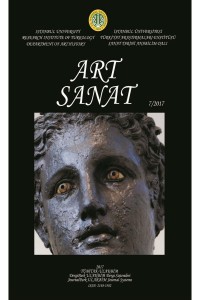Öz
The term of aesthetic was put forward by German philosopher A. G. Baumgarten in the mid-18th century. Since Baumgarten in the historical process, the way aesthetic philosophy came into existence, process of its methodology, hypothetical principles and scientific methods have always been based on the methodology of philosophy. At this point, some philosophers have been determinative to change the general methodology and perspective of aesthetics. Thus, by virtue of these theorists aesthetics have philosophical characteristics and their sources, targets, metaphysical processes and methodologies have been institutionalized. The thought of aesthetics made progress in the 18th century when art was theoretically and historically analyzed. This progress was made especially because of certain philosophers. Hegel, Kant and Marx can be given as examples. Kant based the terms of aesthetics, aesthetic experience and beauty totally on subjective basis and with the dialectic of aesthetic judgment power he introduced the perception of criticism to aesthetics and art. Hegel doctrinated art in the light of modern philosophy and introduced the concepts such as talent and technique to the field of aesthetics. While these philosophers systematized the aesthetics, after 1940s materialist Marxist dialectic replaced the Hegelian dialectic. Marx was the architect of this change. In this study, the aim is to put forward the general laws of aesthetic philosophy, understanding of aesthetic and art in the conversation process of aesthetic process into an idealistic materialistic dialectic and its relationship with other fields of art.
Anahtar Kelimeler
aesthetic methodology aesthetic methods and science Kant Hegel Marx
Kaynakça
- Acar, Adnan. 2012. Estetik, (Marksçı Estetik Toplumsal Gerçeklik), İstanbul: Doruk yayınları.
- Altuğ; Taylan. 2007. Kant Estetiği, İstanbul: Panel Yayınları.
- Bozkurt, Nejat. 1995. Sanat ve Estetik Kuramları, İstanbul: Sarmal Yayınevi.
- Bozkurt, Nejat. 2011. Hegel, İstanbul: Say Yayınları.
- Cevizci, Ahmet. 2012. Eğitim Felsefesi, İstanbul: Say Yayınları.
- Hegel, Georg Wilhelm F. 2012. Estetik, çev. Taylan Altuğ-Hakkı Ünler, İzmir: Payel Yayınları,
- Hyppolite, Jean. 2010. Marx ve Hegel, çev. Doğan Barış-Kılınç, Doğubatı, Ankara.
- Kagan; M. 1993. Estetik ve Sanat Dersleri, çev. Aziz Çalışlar, Ankara: İmge Kitabevi.
- Kant, İmmanuel. 2006. Yargı Gücünün Eleştirisi, çev. Aziz Yardımlı, İstanbul: İdea Yayınları.
- Kula, Onur Bilge. 2012. Estetik ve Edebiyat, (Kant, Schiller, Heidegger), İstanbul: İş Bankası Yayınları.
- Marx, Engels, Lenin. 2006. Sanat ve Edbeiyat, çev. Aziz Çalışlar, İstanbul: Evrensel Basım.
- Yıldırım, İbrahim. 2014. Estetik, Ankara: Aktif Düşünce Yayınları.
- Ziss, Avner. 2009. Estetik, çev. Yakup Şahan, İstanbul: Hayalbaz Kitabevi.
Öz
Estetik terimi, 18.yy ortalarında Alman Filozof A.G.Baumgarten tarafından ortaya atılmıştır. Baumgarten’den buyana, tarihsel süreçte, estetik biliminin nasıl oluştuğu, metadolojisinin süreci ve estetiğin kuramsal ilkeleri ile bilimsel yöntemi, her çağda, felsefenin metadolojisine bağlıdır. Bu noktada, bazı filozofların estetiğin genel yöntembilimini ve bakışı açısını değiştirme de belirleyici oldukları görülmektedir. Böylece bu kuramcıların sayesinde estetik bilimi, felsefi bir özellik taşımakla beraber; bu süreçlerin kaynakları, hedefleri, metafizik süreçleri ve yöntembilimleri kuramsallaşmıştır. Estetik düşüncesi,18.yy’da sanatın kuramsal ve tarihsel olarak çözümlenmesi noktasında gelişme gösterir. Bu gelişme özellikle bazı felsefeciler sayesinde olmuştur. Bu felsefecilere, Hegel, Kant ve Marx örnek verilebilir. Kant, estetik, estetik deneyim ve güzel kavramını tamamen öznel temellere dayandırmış ve estetik yargı gücünün diyalektiği ile estetiğe ve sanat’a eleştiri algısını getirmiştir. Hegel ise Modern felsefe ışığında sanatı ilkeleştirir ve yetenek, teknik gibi kavramları estetik alanına sokar. Bu Filazoflar estetiği sistemleştirirken;. 1940’lardan sonra Hegel’ci diyalektiğin yerini Materyalist Marksist bir diyalektiğe dönüştüğü görülür. Bunun mimarıda Marx olmuştur. Estetik sürecin idealist bakış açısından Materyalist Diyalektik sürece dönüşümünde, estetiğin ve sanatın ne gibi bir anlam taşıdığının anlaşılmasının sağlanması ve sanat bilimleri ile ilişkileri, sanatın konumu ve araştırma ilkeleri, felsefece ve estetik felsefesi ve biliminin genel yasaları ortaya konmaya çalışılmıştır.
Anahtar Kelimeler
Estetik Metadolojisi Estetik Yöntem ve Bilimi Kant Hegel Marx
Kaynakça
- Acar, Adnan. 2012. Estetik, (Marksçı Estetik Toplumsal Gerçeklik), İstanbul: Doruk yayınları.
- Altuğ; Taylan. 2007. Kant Estetiği, İstanbul: Panel Yayınları.
- Bozkurt, Nejat. 1995. Sanat ve Estetik Kuramları, İstanbul: Sarmal Yayınevi.
- Bozkurt, Nejat. 2011. Hegel, İstanbul: Say Yayınları.
- Cevizci, Ahmet. 2012. Eğitim Felsefesi, İstanbul: Say Yayınları.
- Hegel, Georg Wilhelm F. 2012. Estetik, çev. Taylan Altuğ-Hakkı Ünler, İzmir: Payel Yayınları,
- Hyppolite, Jean. 2010. Marx ve Hegel, çev. Doğan Barış-Kılınç, Doğubatı, Ankara.
- Kagan; M. 1993. Estetik ve Sanat Dersleri, çev. Aziz Çalışlar, Ankara: İmge Kitabevi.
- Kant, İmmanuel. 2006. Yargı Gücünün Eleştirisi, çev. Aziz Yardımlı, İstanbul: İdea Yayınları.
- Kula, Onur Bilge. 2012. Estetik ve Edebiyat, (Kant, Schiller, Heidegger), İstanbul: İş Bankası Yayınları.
- Marx, Engels, Lenin. 2006. Sanat ve Edbeiyat, çev. Aziz Çalışlar, İstanbul: Evrensel Basım.
- Yıldırım, İbrahim. 2014. Estetik, Ankara: Aktif Düşünce Yayınları.
- Ziss, Avner. 2009. Estetik, çev. Yakup Şahan, İstanbul: Hayalbaz Kitabevi.
Ayrıntılar
| Birincil Dil | Türkçe |
|---|---|
| Bölüm | MAKALELER/ARTICLES |
| Yazarlar | |
| Yayımlanma Tarihi | 30 Aralık 2017 |
| Gönderilme Tarihi | 12 Aralık 2017 |
| Yayımlandığı Sayı | Yıl 2017 Sayı: 7 |


